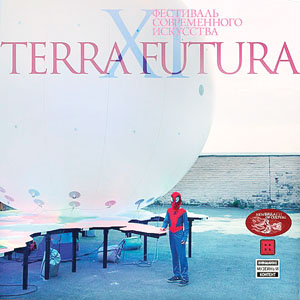
This year, Terra Futura changed its location. Last year’s anniversary event was dedicated to practices and prospects of the city environment revitalization, and was held in the premises of a closed shoe factory. For the first time, the fest went beyond the bounds of regular art shows. Thanks to the urban context, it gained a different conceptual meaning. Undoubtedly, the topic was up-to-date, since Kherson, as well as many other Ukrainian cities, has plenty of abandoned industrial buildings. Festival participants wanted to prove that it is possible to put life back into such places by turning them into art zones. Such practices have been successfully implemented in Europe for 30 years.
The 11th festival conquers a new type of space: museums. The masterminds of this year’s Terra Futura designed a bold goal for the fest: to bring modern art to traditional museums, show cultural and historical heritage from a different point of view, and make it more attractive for the youth. The event’s curator Olena AFANASIEVA told The Day about the special features of the festival art activities. “During 10 days, a group of creative young painters, designers, photographers, and media workers from three countries (Ukraine, Georgia, and Armenia) are going to study local museum context and create innovative art projects based on them. They are going to transform traditional museums into media platforms and culture centers,” says Olena. “Young artists will immerse themselves into the atmosphere of a museum, get inspiration from its collections, and will recreate the impressions in their works (in paintings, installations, performances, etc.) The Shovkunenko Kherson Regional Art Museum is going to participate in this experiment and host the festival. Moreover, when the museum workers learned that Georgian and Armenian artists were going to participate in the fest, they organized an exhibit of works by the 20th century artists from these two countries. A lot of these paintings, which are preserved in the museum holdings, were displayed for the first time. It is hard to predict the reaction of young artists from Georgia and Armenia after they see this exhibition, because they probably did not know about such deep connections between their countries and Ukraine.”
It became possible to invite guests from other countries thanks to the program “The New Breath of Culture: Art Revived by Heritage.” This project is carried out by the Totem Center as a part of the Eastern Partnership Culture Program and is financed by the European Union.
Read also
In order to be invited to master classes and become co-authors of the festival, young artists had to not only fill out a form and send a portfolio of their works, but also write an essay that would start with the words: “I came to the museum, and…”
“They had to demonstrate their original vision of museums and prove that they had a unique way of portraying these institutions, and that was their ticket to Terra Futura,” Afanasieva continues. “As a result, the classical format of the festival (exhibitions, performances, and video screenings) will only be present at the final stage of the long and interesting process that includes master classes, lectures, and the creation of an alternative museum guide. Our very first festivals set the tone for this ‘cultural discovery’ format of our present event. Very few people know that Kherson oblast is the birthplace of futurism. It was here (in village Chornianka, Kakhovka raion) that Davyd Burliuk founded a literature and art community of cube-futurists “Hileia.” In 2002, Totem’s team decided to organize a contemporary art festival, which was held under different names and with different themes in Chornianka, Kherson, and Tsiurupynsk. So, art interventions in space that demand a modern interpretation of their functions as well as inner context are a good tradition of the festival.”
Masterminds of Terra Futura think that the idea of such art forum is far from being exhausted, despite the physical limits of potential platforms. Creative impulse of people, who are not indifferent to the world around them and are willing to improve local cultural situation, does not have boundaries. And Terra Futura is a direct evidence of that.




















































